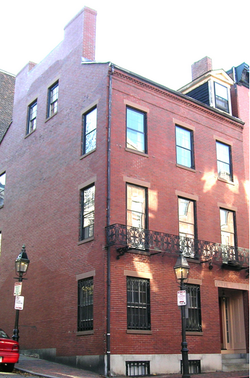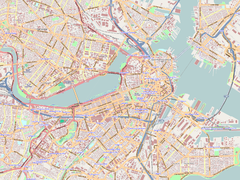John Coburn House: Difference between revisions
→John Coburn: deleting redundant sentence |
Citation bot (talk | contribs) Add: publisher. | Use this bot. Report bugs. | #UCB_CommandLine |
||
| (5 intermediate revisions by 5 users not shown) | |||
| Line 57: | Line 57: | ||
}} |
}} |
||
The '''John Coburn House''' was the home of John Coburn, an African |
The '''John Coburn House''' was the home of [[John P. Coburn]] (1811–1873), an African-American abolitionist who aided people on the [[Underground Railroad]]. The home is currently a private residence. It is on the Black Heritage Trail and its history is included in walking tours by the [[Boston African American National Historic Site]]. |
||
Between 1843 and 1844, Coburn commissioned architect [[Asher Benjamin]] to design a house for him at the corner of Phillips and Irving Streets. Coburn lived there with his wife, Emmeline, and their adopted son Wendell.<ref name="petronella">{{cite book |last1=Petronella |first1=Mary Melvin |title=Victorian Boston Today: Twelve Walking Tours |publisher=UPNE |date=2004 |isbn=9781555536053 |page=137 |url=https://books.google.com/books?id=Qg_uLLXLY5kC&pg=PA137}}</ref><ref name="curtis">{{cite book |last1=Curtis |first1=Nancy C. |title=Black Heritage Sites: An African American Odyssey and Finder's Guide |publisher=American Library Association |date=1996 |isbn=9780838906439 |page=295 |url=https://books.google.com/books?id=Rk7NPRm_nB0C&pg=PA295}}</ref> |
|||
== John Coburn == |
|||
John Coburn (1811–1873) was a clothing retailer and community activist. He served as treasurer of |
|||
the [[New England Freedom Association]], an organization dedicated to helping people escape from |
|||
slavery. In 1851 he was arrested, tried, and acquitted for the court-house rescue of [[Shadrach Minkins]], a freedom seeker who was caught in Boston by federal slave catchers empowered by the [[Fugitive Slave Act of 1850]]. Coburn was co-founder and captain of the [[Massasoit Guards]], a black military company in 1850s Boston that was a precursor to the [[54th Regiment Massachusetts Volunteer Infantry]].<ref name="NPS BOAF-S2">{{ cite web | url=http://www.nps.gov/boaf/planyourvisit/upload/BOAF_S2.pdf | title =Boston African American NHS Park Brochure, Side 2 | publisher=National Park Service | accessdate=April 26, 2013 }} {{NPS}}</ref> |
|||
== Black Heritage Trail == |
== Black Heritage Trail == |
||
The house is a [[Boston African American National Historic Site|Boston African |
The house is a [[Boston African American National Historic Site|Boston African-American historical site]] located on the Black Heritage Trail in [[Beacon Hill, Boston|Beacon Hill]].<ref name="NPS BOAF-S2">{{cite web |url=http://www.nps.gov/boaf/planyourvisit/upload/BOAF_S2.pdf |title=Boston African American NHS Park Brochure, Side 2 |publisher=National Park Service}}</ref><ref name="Fodor's2008">{{cite book|author=Fodor's|title=The Official Guide to America's National Parks, 13th Edition|url=https://books.google.com/books?id=YO_f5OXL_6YC&pg=PA441|accessdate=April 26, 2013|date=December 16, 2008|publisher=Fodor's Travel Publications|isbn=978-1-4000-1628-0|pages=441–}}</ref><ref name="Scott">{{cite book|author1=David L. Scott|author2=Kay W. Scott|title=Guide to the National Park Areas, Eastern States|url=https://books.google.com/books?id=Z8DCRmgPOewC&pg=PA110|accessdate=April 26, 2013|work=Globe Pequot|pages=110–112 |isbn=9780762729883|date=2004|publisher=Globe Pequot Press }}</ref><ref name="NPS BOAF-S1" /> |
||
The National Park Services wrote: |
The National Park Services wrote: |
||
<blockquote>The historic buildings along today's |
<blockquote>The historic buildings along today's Black Heritage Trail<sup>[[®]]</sup> were the homes, businesses, schools and churches of a thriving black community that organized, from the nation's earliest years, to sustain those who faced local discrimination and national slavery, struggling toward the equality and freedom promised in America's documents of national liberty.<ref name="NPS BOAF-S1">{{ cite web | url=http://www.nps.gov/boaf/planyourvisit/upload/BOAF_S1.pdf | title =Boston African American NHS Park Brochure, Side 1 | publisher=National Park Service | accessdate=April 26, 2013 }} {{NPS}}</ref></blockquote> |
||
[[File:Boston African-American Heritage Trail.JPG|thumb|center|450px|[[Black Heritage Trail|Boston African American Heritage Trail]]]] |
[[File:Boston African-American Heritage Trail.JPG|thumb|center|450px|[[Black Heritage Trail|Boston African American Heritage Trail]]]] |
||
==References== |
==References== |
||
{{Reflist}} |
{{Reflist|30em}} |
||
==External links== |
==External links== |
||
| Line 82: | Line 79: | ||
[[Category:African-American history in Boston]] |
[[Category:African-American history in Boston]] |
||
[[Category:History of Boston]] |
[[Category:History of Boston]] |
||
[[Category: |
[[Category:Houses in Boston]] |
||
[[Category:Beacon Hill, Boston]] |
[[Category:Beacon Hill, Boston]] |
||
[[Category:African-American abolitionists]] |
[[Category:African-American abolitionists]] |
||
Latest revision as of 13:28, 23 August 2023
| John Coburn House | |
|---|---|
 | |
| General information | |
| Location | Beacon Hill |
| Address | Private residence: 2 Phillips Street |
| Town or city | Boston |
| Country | United States |
| Coordinates | 42°21′37″N 71°03′59″W / 42.360337°N 71.066381°W |
The John Coburn House was the home of John P. Coburn (1811–1873), an African-American abolitionist who aided people on the Underground Railroad. The home is currently a private residence. It is on the Black Heritage Trail and its history is included in walking tours by the Boston African American National Historic Site.
Between 1843 and 1844, Coburn commissioned architect Asher Benjamin to design a house for him at the corner of Phillips and Irving Streets. Coburn lived there with his wife, Emmeline, and their adopted son Wendell.[1][2]
Black Heritage Trail[edit]
The house is a Boston African-American historical site located on the Black Heritage Trail in Beacon Hill.[3][4][5][6]
The National Park Services wrote:
The historic buildings along today's Black Heritage Trail® were the homes, businesses, schools and churches of a thriving black community that organized, from the nation's earliest years, to sustain those who faced local discrimination and national slavery, struggling toward the equality and freedom promised in America's documents of national liberty.[6]

References[edit]
- ^ Petronella, Mary Melvin (2004). Victorian Boston Today: Twelve Walking Tours. UPNE. p. 137. ISBN 9781555536053.
- ^ Curtis, Nancy C. (1996). Black Heritage Sites: An African American Odyssey and Finder's Guide. American Library Association. p. 295. ISBN 9780838906439.
- ^ "Boston African American NHS Park Brochure, Side 2" (PDF). National Park Service.
- ^ Fodor's (December 16, 2008). The Official Guide to America's National Parks, 13th Edition. Fodor's Travel Publications. pp. 441–. ISBN 978-1-4000-1628-0. Retrieved April 26, 2013.
- ^ David L. Scott; Kay W. Scott (2004). Guide to the National Park Areas, Eastern States. Globe Pequot Press. pp. 110–112. ISBN 9780762729883. Retrieved April 26, 2013.
{{cite book}}:|work=ignored (help) - ^ a b "Boston African American NHS Park Brochure, Side 1" (PDF). National Park Service. Retrieved April 26, 2013.
 This article incorporates public domain material from websites or documents of the National Park Service.
This article incorporates public domain material from websites or documents of the National Park Service.

